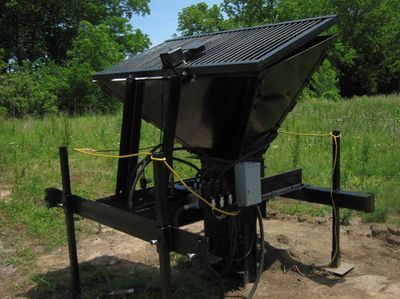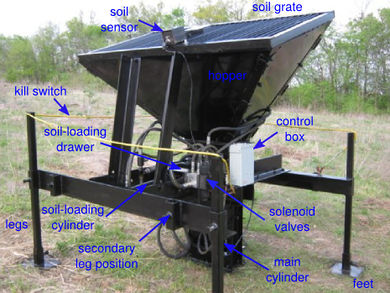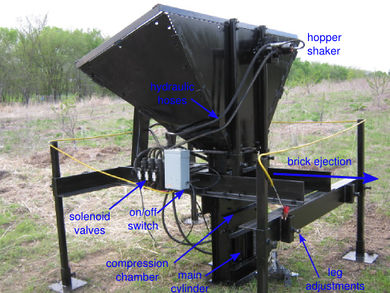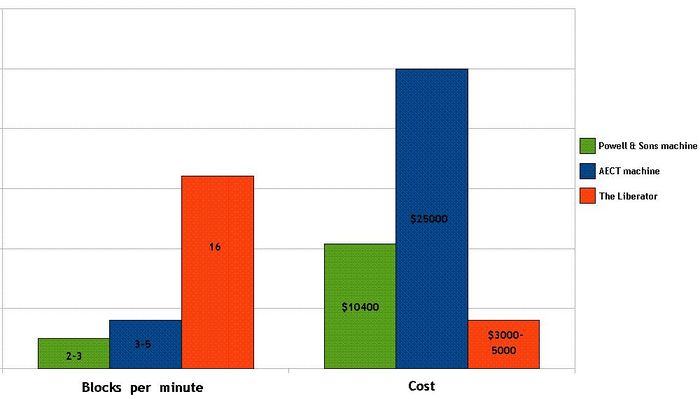CEB Press Intro: Difference between revisions
| Line 19: | Line 19: | ||
<div align="center"><html> | <div align="center"><html> | ||
<object width="300" height="270"><param name="movie" value="http://www.youtube.com/v/zoPq639C4CA&hl=en&fs=1"></param><param name="allowFullScreen" value="true"></param><param name="allowscriptaccess" value="always"></param><embed src="http://www.youtube.com/v/zoPq639C4CA&hl=en&fs=1" type="application/x-shockwave-flash" allowscriptaccess="always" allowfullscreen="true" width="300" height="260"></embed></object> | <object width="300" height="270"><param name="movie" value="http://www.youtube.com/v/zoPq639C4CA&hl=en&fs=1"></param><param name="allowFullScreen" value="true"></param><param name="allowscriptaccess" value="always"></param><embed src="http://www.youtube.com/v/zoPq639C4CA&hl=en&fs=1" type="application/x-shockwave-flash" allowscriptaccess="always" allowfullscreen="true" width="300" height="260"></embed></object> | ||
</html></div> | </html> | ||
<html> | |||
<iframe src="https://player.vimeo.com/video/22102016?title=0&byline=0&portrait=0" width="400" height="233" frameborder="0"></iframe><p><a href="http://vimeo.com/22102016">Complete CEB Walkthrough</a> from <a href="http://vimeo.com/user2016419">Open Source Ecology</a> on <a href="http://vimeo.com">Vimeo</a>.</p> | |||
</html> | |||
</div> | |||
===List of components=== | ===List of components=== | ||
| Line 51: | Line 56: | ||
{{Wanted|Demo Photos.}} | {{Wanted|Demo Photos.}} | ||
{{Wanted|Video of building with it}}. Check youtube channel - [http://www.youtube.com/watch?v=C_9rQ61wi_o][http://www.youtube.com/watch?v=aN5o-mdO1CY][http://www.youtube.com/watch?v=y4cTyHedH58][http://www.youtube.com/watch?v=9OU5ulNgiqo][http://www.youtube.com/watch?v=ju_tAn7Mw5c] | {{Wanted|Video of building with it}}. Check youtube channel - [http://www.youtube.com/watch?v=C_9rQ61wi_o][http://www.youtube.com/watch?v=aN5o-mdO1CY][http://www.youtube.com/watch?v=y4cTyHedH58][http://www.youtube.com/watch?v=9OU5ulNgiqo][http://www.youtube.com/watch?v=ju_tAn7Mw5c] | ||
==Specifications== | ==Specifications== | ||
Revision as of 00:59, 4 July 2011
| CEB Press | ||
|---|---|---|
| Home | Research & Development | Bill of Materials | Manufacturing Instructions | User's Manual | User Reviews | 
| |
The "Liberator" Compressed Earth Block Press is a machine that makes compressed earth blocks (CEBs). It takes earth/dirt/soil and squeezes it really hard to make solid blocks which can be used for building. Compressed earth blocks have many advantages as a building material: by making the building materials from the ground on the site, they eliminate the need to cart them in from elsewhere. This cuts down the costs and environmental impact of transport. Compressed earth blocks are very strong and insulate well against both heat and sound. This makes for a very energy-efficient building. Best of all, there is no charge for using dirt; it is literally a dirt-cheap way of building! See the wiki page on Compressed Earth Blocks and the CEB category for more details on building with CEBs.
The Liberator has been fully designed and tested by the Open Ecology team. You can now follow the instructions to build your own, or contact us if you want to buy a kit or a finished machine.
Building a machine yourself might seem scary, but every step of the process is fully documented and the OSE community is available on our discussion forums if you need help, advice, or a little hand-holding.
With the Liberator, two people can build a 6 foot high (1.83m) round wall, 20 feet (6.1m) in diameter, 1 foot (30cm) thick, in one 8 hour day - though construction time will vary somewhat depending on other factors: preparation time, what equipment is available (tractor etc.) and the quality of the soil. The bigger the block size, the faster a wall is errected. And obviously, the bigger the block size, the heavier the block. Blocks from The Liberator will average 25 pounds (11.3kg).
The torch table will be used to automate the fabrication of the CEB machine, reducing fabrication time by an estimated 20 hours and thus reducing the cost of the final product.
How does it work?
Loose dirt is loaded into the hopper at the top. This falls through to a chamber where a pair of hydraulic arms compress it and then eject it. This video shows how the machine works:
List of components
The purpose is to explain the design very simply so that when it is explained in detail later, it will be easier to understand
The Liberator consists of -
Wanted: Refine this list (perhaps based on The Liberator Master Bill of Materials ). This list should be the model for the build instructions.
- A hopper at the top which you fill with loose dirt. This is made from welded steel. We made the hopper six feet wide, so it can hold a lot of dirt.
- Grate and grate shaker - the grate is at the bottom of the hopper. The grate shaker shakes it so that soil falls through into the compression chamber, while large stones and things like that are caught in the grate.
- A compression chamber where the bricks are actually pressed. This is a metal box with a nylon liner bolted on the inside. The liner gives the bricks a smoother finish. It will have to be replaced every hundred thousand bricks or so.
- A frame that bolts together for easy assembly and disassembly.
- Hydraulic cylinders - These are the muscles of the machine; they apply the pressure to the dirt. They are readily removable with pins. There are two hydraulic cylinders:
- The soil drawer - this moves from left to right and performs the dual function of loading soil into the compression chamber and ejecting blocks from the machine
- The main cylinder, which moves up and down and compresses the blocks
- Tractor mount - this is where an external hydraulic power source can be attached to the hydraulic cylinders.
- Pressure gauge
- Arduino board controls the timing and sequence of operations.
Product Ecology
- Rototiller to prepare the soil.
- Power source such as LifeTrac.
- Tractor to load the hopper (optional)
Wanted: Cost assessment of this. How much would an external hydraulic power source cost?
The Liberator in action
Wanted: Demo Photos.
Wanted: Video of building with it
. Check youtube channel - [1][2][3][4][5]
Specifications
| Bricks per minute output | 16 |
|---|---|
| Brick size | 12x6x6 inches (30.5x15.3x10.2 cm) |
| People operating machine | 1-2 |
| Power source | Tractor hydraulics or any hydraulic power source with 6 gallon per minute capacity (22.71 liters per minute) |
| Machine mounting | tractor 3 point hitch or stand-alone foot |
| Hydraulic pressure | 2000psi / 137.90 bar |
| Hydraulic cylinder | 5 inch diameter, 19.6 inch area; 2.5 inch rod |
| Pressing cylinder pressure | 39,250 lb pushing force (~18 tons) |
| Controls | 2 spool, manual, hydraulic valve; automatic version forthcoming. |
| Compressive strength of bricks | 795psi (54.81 bar) using plain earth. 1200psi (82.74 bar) with 10% Portland cement. Strong enough to build a 60 storey building [6] |
| Structural cold rolled steel construction throughout |
- Height: 6 foot 11 inches/ 210.82 cm
- Machine lifetime goals: 1 million bricks before repairs; liner may be replaced every 100,000 bricks
- Fabrication time requirement for optimized production: 3-5 days, about 20 hours of direct fabrication
- Manual fabrication tooling requirements: drill press, welder, acetylene torch
- Optimal fabrication tooling: XYZ table with torch, MIG welder, hoist
- Material costs: $1000-1350
- Cost for machine: you can build your own for $3-5k in parts, or buy a readymade one here for $8k
(All prices above are in US dollars.)
Advantages of The Liberator
- Easy repair. The Liberator was designed to make maintenance as easy and infrequent as possible. The part that is most likely to need replacement is a rubber sheet from McMaster-Carr. The press is designed for disassembly, so if repairs are needed, the cost should be minimal. And unlike commercial machines, you have all the blueprints and sources for parts here, so there should be no difficulty repairing it.
- Requires as little as 1 person to operate. The only control required is turning the machine on, and from that point one simply loads soil and unloads bricks. There is an alternative manual version for $500 less (Is that correct?)
- Modular power source. The Liberator does not have its own power source; it is designed to be attached to an external power source. This is in line with the OSE principle of modularity; different tools can be run from the same power source, allowing the same tool to fulfill many functions flexibly. The power source could be the hydraulics from LifeTrac (our tractor any flexible source of machanical power), Power Cube, or any hydraulic power source with a capacity of 6 gallon per minute (22.71 liters per minute).
- Large hopper. Compared to other CEB presses on the market, The Liberator has a very large hopper. We found with earlier editions that a small hopper requires constant loading and this slows down the construction process.



